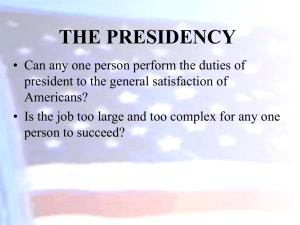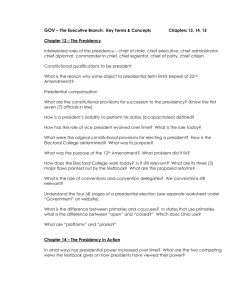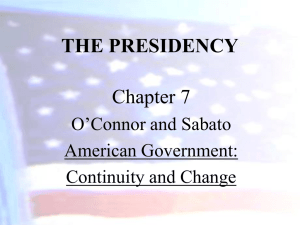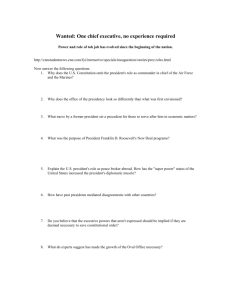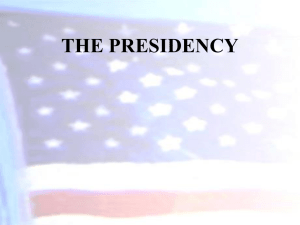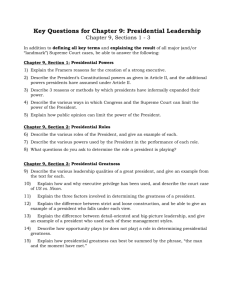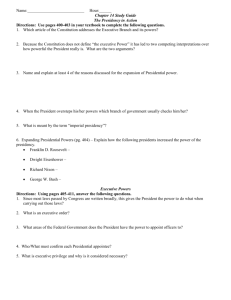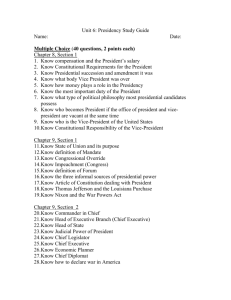THE PRESIDENCY
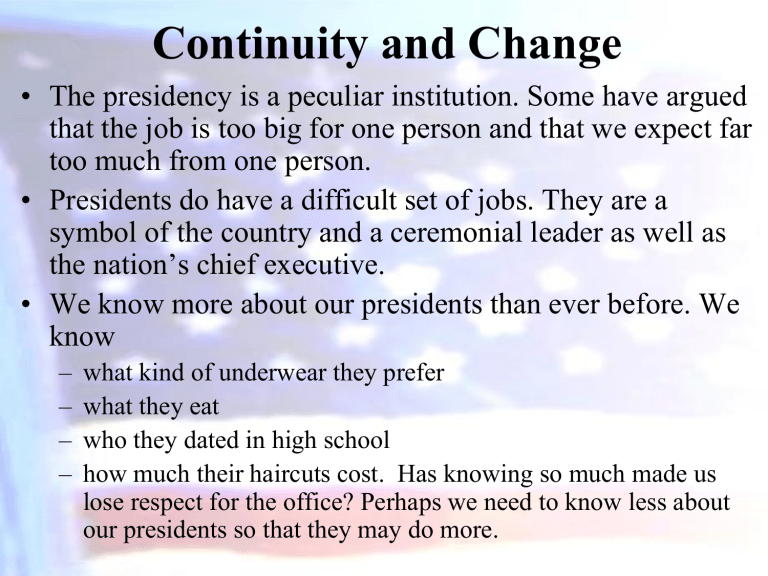
Continuity and Change
• The presidency is a peculiar institution. Some have argued that the job is too big for one person and that we expect far too much from one person.
• Presidents do have a difficult set of jobs. They are a symbol of the country and a ceremonial leader as well as the nation’s chief executive.
• We know more about our presidents than ever before. We know
– what kind of underwear they prefer
– what they eat
– who they dated in high school
– how much their haircuts cost. Has knowing so much made us lose respect for the office? Perhaps we need to know less about our presidents so that they may do more.
The Constitutional Convention
Qualifications for Office
• The Constitution requires that the president must be:
– thirty-five years old
– fourteen years a U.S. resident
– a natural-born citizen
Terms of Office
• The length of the president's term was quite controversial.
• Four, seven, and eleven-year terms were suggested at the
Convention and several of the Framers suggested a limit of one or two terms.
• The Twenty-Second Amendment now limits presidents to two four-year terms or a total of ten years in office.
Removal of a President
• Removal is the ultimate check on the president.
• The House conducts the investigation and drafts
Articles of Impeachment for “treason, bribery, or high crimes and misdemeanors.”
• The Senate tries the case with the Chief Justice of the Supreme Court presiding.
• If two-thirds of the Senate votes for the Articles, the president is removed from office.
• Only two presidents have been impeached:
Andrew Johnson and William Jefferson Clinton.
Neither were removed from office.
Succession
• Through 2011, seven presidents have died in office (plus
Nixon’s resignation).
• If the president is unable to perform his duties, the vice president then becomes responsible for the office.
• Congress passed the Presidential Succession Act of 1947 that stated the order of succession after the Vice
President:
– Speaker of the House
– President Pro Tempore of the Senate
– Secretary of State, Treasury, Defense, and other Cabinet heads in order of the creation of their department
• The Twenty-Fifth Amendment (1967) lays out succession and allows the president to appoint a new vice president if the post is vacant.
2. The Constitutional
Powers of the President
• Article II is quite short and details few powers for the president.
• The president received certain enumerated powers in the
Constitution; however, the first line of Article II may be the most important grant of power to the president.
• It states “the executive power shall be vested in a
President of the United States of America.”
• The executive power clause has been the basis for allowing the president to exceed the list of enumerated powers in Article II.
Pardoning
Power
Legislative
Power
Chief-of-State
Treaty-making
Power
Chief Diplomat Chief Executive
Commander
-in-Chief
Appointment
Power
Veto Power
3. Development of
Presidential Power
• All presidents have had similar formal parameters of checks and balances via the Constitution.
• The power and success of the presidency is dependent upon:
– the personality of the person holding the office
– the informal powers of the presidency
– the goals of the officeholder
– the timing of events…events often shape a presidency
(for example, crises often lead to an expansion of presidential powers)
Informal Executive powers
These powers are NOT found anywhere in the Constitution. Constitutional scholars differ on whether they are actually
Constitutional.
Executive orders
Executive Privilege
Executive Agreements
Presidential Signing Statements
Unitary Executive
Unitary Executive Part II
4. The Presidential Establishment
• Today, the president has numerous advisors to help make policy and fulfill the duties of chief executive:
– The Cabinet
– The Executive Office of the President
(EOP)
– White House Staff
– The First Lady
The Cabinet
• The Cabinet is not mentioned in the Constitution and is formulated by each president as he/she sees fit.
• The Cabinet consists of the heads of the major bureaucratic departments (State, Defense,
Treasury, etc.).
• Congress exercises some control over the bureaucracy -- through advice and consent and budget controls.
The Executive Office of the President (EOP)
• The EOP was established by FDR and is a very important inner circle of advisors to the president.
• The EOP is staffed by persons responsible to the president alone.
• The EOP includes such important offices as the
National Security Council, the Council of
Economic Advisors, and the Office of
Management and Budget.
White House Staff
• The people most directly responsible to the president are the White House staff such as personal assistants, senior aides, administrative personnel, and more.
• There is no Senate confirmation and their power comes solely from their personal relationship with the president.
• The White House staff reached a height of 583 members in 1972, but has gotten smaller since and is generally around 400.
5.
The Role of the President in the
Legislative Process:
The President as Policy Maker
• FDR claimed the leadership and agenda-setting power for the president and got it.
• FDR shifted the president’s powers from that of simply executing policy to making it.
• However, presidents have a hard time getting
Congress to pass their programs especially during periods of divided government.
6. The President and Public Opinion
• Bill Clinton spoke to the public in a variety of media configurations about 550 times a year.
• Ronald Reagan averaged 320 appearances a year.
• Harry Truman—only 88 time a year.
• “Going Public”: the act of going over the heads of Congress members to gain direct support from the people.
Presidential Approval
Ratings
Presidential
Leadership
Patronage
Public Opinion
Appointment
Power
Party
Persuasion
Veto Power


